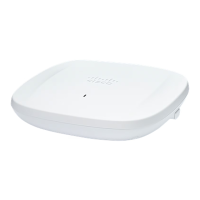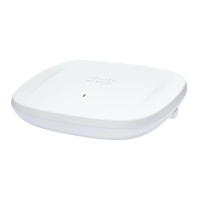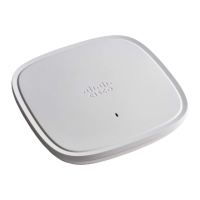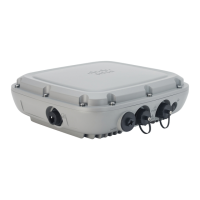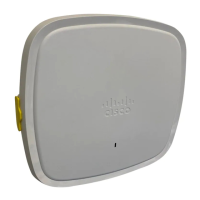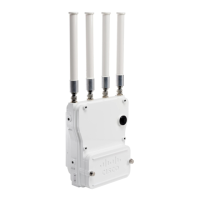Do you have a question about the Cisco Catalyst 9166 Series and is the answer not in the manual?
Describes the guide's content and provides information on conventions and related documentation.
Explains the document's use of conventions for notes, cautions, and safety warnings.
Lists user documentation and configuration guides for the access point.
Provides links to Cisco resources for timely information, services, support, and training.
Details the Cisco Bug Search Tool (BST) for tracking product defects and vulnerabilities.
Explains how to provide feedback on Cisco technical documentation.
Introduces the Cisco Catalyst 9166 Series Wi-Fi 6E Access Point as an enterprise-class tri-band access point.
Details the hardware and supporting features of the CW9166I AP, including its radios and sensors.
Lists AP model numbers and provides a link to verify regulatory domain approvals.
Describes the internal antennas and radios used by the AP.
Details the types and configurations of internal antennas for the CW9166I AP.
Presents tables of operating frequencies and maximum output power for different regions.
Describes how to view the AP and lists its ports and connectors for powering.
Illustrates the available ports and connectors on the Cisco Catalyst 9166 Series Wi-Fi 6E Access Point.
Presents illustrations of the radiation patterns for the CW91661 model with internal antennas.
Lists the items included in each AP package, including default and optional mounting brackets.
Provides a procedure for unpacking and verifying the contents of the access point shipment.
Lists accessories that can be ordered separately from Cisco, such as mounting brackets and power injectors.
Details the optional procedure for configuring the AP before final installation and initial operation.
Recommends site surveys and lists information needed for installation, including locations and power options.
Describes various locations for mounting the AP and provides links to mounting instructions.
Explains the supported power sources for the AP, including PoE standards and DC power.
Explains the process of discovering and joining a controller, including requirements and methods like DHCP or DNS.
Outlines steps for deploying the AP after mounting, including powering up and observing the LED status.
Describes the access point status LED indications and their meanings for troubleshooting.
Explains how to use the Mode button to reset the AP to factory defaults or clear internal storage.
Provides guidance on resolving issues when an AP fails to join a Cisco controller.
Lists key guidelines for using CW9166I APs with Cisco wireless controllers.
Details how to configure DHCP Option 43 to provide controller IP addresses to APs for discovery.
Provides important safety warnings related to installation, electrical codes, and RF exposure limits.
Provides the FCC Declaration of Conformity statement for the Cisco CW91661-B model.
Presents the VCCI compliance statement for Japan, applicable to specific access point models.
Offers guidelines for avoiding interference when operating access points in Japan.
Details the compliance statement for Canada, including license-exempt transmitter requirements.
Covers CE mark compliance for the EU and EFTA countries, including operating restrictions.
Specifies compliance requirements for the United Kingdom, including indoor use restrictions.
Outlines administrative rules for operating access points in Taiwan, including frequency band limitations.
Provides information on operating Cisco Catalyst access points in Brazil.
Contains information on compliance with guidelines related to RF exposure.
Discusses compliance with national and international standards on Human Exposure to Radio Frequencies.
Confirms compliance with international RF exposure guidelines and specifies a minimum separation distance.
Confirms compliance with FCC RF exposure limits and specifies a minimum separation distance.
Confirms compliance with Health Canada RF exposure guidelines and specifies separation distances.
Describes the guide's content and provides information on conventions and related documentation.
Explains the document's use of conventions for notes, cautions, and safety warnings.
Lists user documentation and configuration guides for the access point.
Provides links to Cisco resources for timely information, services, support, and training.
Details the Cisco Bug Search Tool (BST) for tracking product defects and vulnerabilities.
Explains how to provide feedback on Cisco technical documentation.
Introduces the Cisco Catalyst 9166 Series Wi-Fi 6E Access Point as an enterprise-class tri-band access point.
Details the hardware and supporting features of the CW9166I AP, including its radios and sensors.
Lists AP model numbers and provides a link to verify regulatory domain approvals.
Describes the internal antennas and radios used by the AP.
Details the types and configurations of internal antennas for the CW9166I AP.
Presents tables of operating frequencies and maximum output power for different regions.
Describes how to view the AP and lists its ports and connectors for powering.
Illustrates the available ports and connectors on the Cisco Catalyst 9166 Series Wi-Fi 6E Access Point.
Presents illustrations of the radiation patterns for the CW91661 model with internal antennas.
Lists the items included in each AP package, including default and optional mounting brackets.
Provides a procedure for unpacking and verifying the contents of the access point shipment.
Lists accessories that can be ordered separately from Cisco, such as mounting brackets and power injectors.
Details the optional procedure for configuring the AP before final installation and initial operation.
Recommends site surveys and lists information needed for installation, including locations and power options.
Describes various locations for mounting the AP and provides links to mounting instructions.
Explains the supported power sources for the AP, including PoE standards and DC power.
Explains the process of discovering and joining a controller, including requirements and methods like DHCP or DNS.
Outlines steps for deploying the AP after mounting, including powering up and observing the LED status.
Describes the access point status LED indications and their meanings for troubleshooting.
Explains how to use the Mode button to reset the AP to factory defaults or clear internal storage.
Provides guidance on resolving issues when an AP fails to join a Cisco controller.
Lists key guidelines for using CW9166I APs with Cisco wireless controllers.
Details how to configure DHCP Option 43 to provide controller IP addresses to APs for discovery.
Provides important safety warnings related to installation, electrical codes, and RF exposure limits.
Provides the FCC Declaration of Conformity statement for the Cisco CW91661-B model.
Presents the VCCI compliance statement for Japan, applicable to specific access point models.
Offers guidelines for avoiding interference when operating access points in Japan.
Details the compliance statement for Canada, including license-exempt transmitter requirements.
Covers CE mark compliance for the EU and EFTA countries, including operating restrictions.
Specifies compliance requirements for the United Kingdom, including indoor use restrictions.
Outlines administrative rules for operating access points in Taiwan, including frequency band limitations.
Provides information on operating Cisco Catalyst access points in Brazil.
Contains information on compliance with guidelines related to RF exposure.
Discusses compliance with national and international standards on Human Exposure to Radio Frequencies.
Confirms compliance with international RF exposure guidelines and specifies a minimum separation distance.
Confirms compliance with FCC RF exposure limits and specifies a minimum separation distance.
Confirms compliance with Health Canada RF exposure guidelines and specifies separation distances.
| Category | Wireless Access Point |
|---|---|
| Maximum Data Rate | Up to 4.8 Gbps |
| Supported Frequency Bands | 2.4 GHz, 5 GHz, 6 GHz |
| MIMO | Yes |
| Internal Antennas | Yes |
| External Antennas | No |
| Mounting | Ceiling, Wall |
| Model | Cisco Catalyst 9166 Series |
| Wi-Fi Generation | Wi-Fi 6 |
| Wireless Standards | IEEE 802.11a/b/g/n/ac/ax |
| Operating Modes | Access Point |
| MIMO Configuration | 8x8 |
| Power | 802.3at PoE+ |
| Power Source | PoE, AC |
| Operating Temperature | 0°C to 40°C (32°F to 104°F) |
| Weight | 1.5 kg |




